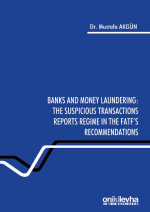 The banking industry has long been the battleground between money launderers and law enforcement agencies. Money launderers have long and frequently misused banking products and services to launder the proceeds acquired through criminal activities. The need to curb the abuse of banking products and services led to law enforcement agencies initiating Anti-Money Laundering institutions to be utilized by the banking industry.
It can often be a cat and mouse game between law enforcement agencies and money launderers, each trying to outwit the other. A new measure taken by the agencies to reduce criminal activities was the adoption of the Suspicious Transactions Reports.
This book captures the current situation between the banking industry and its fight against money laundering. It examines the necessity and proportionality of the Financial Action Task Force's (FATF) global standards against money laundering; and analyses the Suspicious Transaction Reports regime and its subsequent recommendations.(ARKA KAPAKTAN)
The banking industry has long been the battleground between money launderers and law enforcement agencies. Money launderers have long and frequently misused banking products and services to launder the proceeds acquired through criminal activities. The need to curb the abuse of banking products and services led to law enforcement agencies initiating Anti-Money Laundering institutions to be utilized by the banking industry.
It can often be a cat and mouse game between law enforcement agencies and money launderers, each trying to outwit the other. A new measure taken by the agencies to reduce criminal activities was the adoption of the Suspicious Transactions Reports.
This book captures the current situation between the banking industry and its fight against money laundering. It examines the necessity and proportionality of the Financial Action Task Force's (FATF) global standards against money laundering; and analyses the Suspicious Transaction Reports regime and its subsequent recommendations.(ARKA KAPAKTAN)
Table of Contens
Chapter I
Introduction
I. Area of research and arguments
II. Key concepts
A. Economic crime and economic criminal
B. Suspicious transaction reports and other types of reports
1. Suspicious Transaction Reports and Suspicious Activity Reports
2. Threshold reports
Chapter II
Banking industry and money launderers
I. Introduction
II. Confiscation measures and the offence of money laundering
A. Confiscation measures
B. The offence of money laundering
1. A short history of the offence of money laundering
2. Definition and justification of the offence of money laundering
C. Follow the money approach
D. Reaction of the economic criminals
III. Banking business as the target of money launderers
A. The extent to which money launderers threaten the banking industry
B. The reason why the banking industry is threatened by money launderers
1. What do money launderers need to develop hard-to-detect money laundering schemes?
2. What can the banking industry offer money launderers?
Chapter III
Banks as the Private Policemen of the Financial Sphere : the Suspicious Transaction Reports Regime
I. Introduction
II. Banks as the private policemen of the financial sphere
A. Historical overview of the banks' place in the fight against economic crime
1. From hands-off approach to private policeman duties and privileges
2. From rule-based and case-based approaches to a risk-based-approach
B. The FATF's STRs regime related recommendations
1. Evolution of the FATF's STRs regime related recommendations
2. Financial institutions' duty of reporting and the FATF's recommendations
3. Rules that protect reporters from criminal and civil liability
C. Customer Due Diligence and record keeping measures supporting the STRs regime
1. When are banks required to apply CDD measures?
2. What is the content of the CDD measures?
III. Necessity and proportionality of the FATF's STRs related recommendations
List of References
